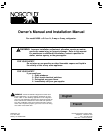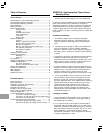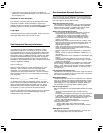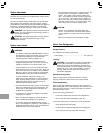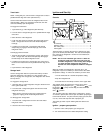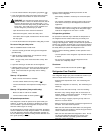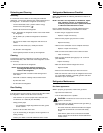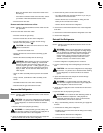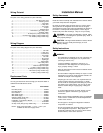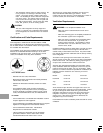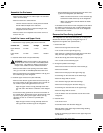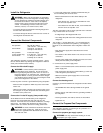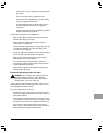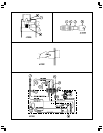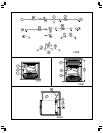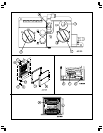
Installation and Owner’s Manual 6
Refrigerator Care Checklist
Your refrigerator will give you years of trouble free service if you
do these simple checks every three to six months:
- Keep the food compartment clean. See “Defrosting and
Cleaning”.
- Defrost the refrigerator as necessary. See “Defrosting and
Cleaning”.
- Make sure the door seals correctly. See “Door Sealing“.
- Be aware of any cooling changes that are not because of
weather, loading, or thermostat changes. If changes occur,
contact your dealer or service center.
- Make sure the gas supply is propane gas only and is not
butane or a butane mixture.
- When in propane gas operation, examine the appearance of
the flame. See “Gas Flame Inspection”.
- Make sure the air flow in the lower intake vent, through the
refrigerator coils and condenser, and out the upper exhaust
vent is not blocked or decreased.
- Make sure the area behind the refrigerator is clear. Do not
use the area behind the refrigerator for storage of any
combustible materials, especially gasoline and other
flammable vapors and liquids.
DC operation guidelines:
DC operation is intended only to maintain the temperature of
the refrigerator and its contents when they are already cool.
The DC operation is not intended for the initial start up and
cooling of the refrigerator. Always use either the AC operation or
propane gas operation to initially start up and cool the refrigera-
tor. The refrigerator must be cooled and the temperature must
be steady before you operate the refrigerator on DC.
Keep in mind the following guidelines for DC operation of the
refrigerator:
- Use DC operation of the refrigerator only while the vehicle is
in transit.
- Do not use DC operation until the refrigerator and its
contents are completely cooled.
Shut down:
- Turn the selector switch to the OFF position ( ).
3. Turn the selector switch to the propane gas position (
).
4. Push and hold in the safety valve and in rapid succession,
push in the igniter several times for about five seconds.
WARNING: Do not hold in the safety valve for more
than 30 seconds. If there is no flame in this time, wait at
least five minutes before you try ignition again. If you
continue to hold in the safety valve, gas will collect in the
burner area. This could cause a fire or explosion and
result in dangerous personal injury or death.
- Open the burner box door and look for the flame.
- When the flame ignites, release the safety valve.
- If the flame does not ignite, wait about five minutes and do
this step again.
5. Turn the thermostat to the temperature setting that you wish.
Do a test of the gas safety valve:
With an established flame in GAS mode:
1. Close the manual gas shutoff valve [2] of the refrigerator
(See Art01035].
2. After the flame is extinguished, you should hear a sharp
“click” sound within three minutes.
NOTE: The gas safety valve should close with a sharp “click“
sound.
3. Open the manual gas shutoff valve of the refrigerator.
4. Without pushing in the gas control, push the igniter several
times rapidly in succession. The burner flame should not
ignite. This means that the gas safety valve is working
correctly.
Start up - AC operation:
- Make sure that 120 volts AC is available.
- Turn the selector switch to the AC position (
).
- Turn the thermostat to the temperature setting that you
wish.
Start up - DC operation (3-way models only):
- Make sure that 12 volts DC is available.
- Turn the selector switch to the DC position (
).
DC operation precautions:
This refrigerator is made to operate on DC power while your
vehicle is “in transit” and AC power or propane gas sources
are not available. Operate the refrigerator on DC power only
when the vehicle engine is running.
For the refrigerator to operate correctly on DC power, the battery
must be maintained in a fully charged condition. For the battery
to be fully charged at all times during refrigerator operation on
DC, the vehicle engine
must be running and the alternator must
be in good operating condition.
Keep in mind the following electrical precautions for DC
operation of the refrigerator:
- Good battery condition is necessary for correct DC opera-
tion.
- The capacity of the battery charging system must be more
than what is necessary for the refrigerator and other DC
appliances.
- While the vehicle engine is running, have a qualified service
technician make sure the voltage of the DC power supply
leads at the refrigerator is more than 11.5 VDC.



